 I’ve talked extensively about traditional HID and LED grow lights systems, but there’s a recent trend with a third new grow light system that you may not know about. Ceramic Metal Halides or CMH for short. I will be describing them here and also giving you my top picks for the best CMH Lights for 2020.
I’ve talked extensively about traditional HID and LED grow lights systems, but there’s a recent trend with a third new grow light system that you may not know about. Ceramic Metal Halides or CMH for short. I will be describing them here and also giving you my top picks for the best CMH Lights for 2020.
Are CMH Grow Lights Better than Other HID Grow Lights in 2020?
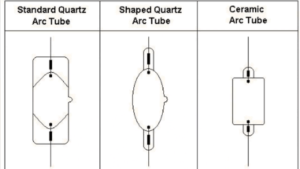 CMH lights were actually discovered in the 1980s but with recent discoveries and horticulture research, they’re beginning to catch more and more wind. So why are so many seasoned growers starting to ditch HPS to CMH grow lights? Right off the bat, once you turn on a CMH bulb, you’ll notice a much more natural-looking light spectrum, no strong orange or yellow hues like an HPS bulb or the bright white and subtle blues from metal halide. So why is it that Standard metal halide bulbs use a quartz arc tube. Whereas CMH use ceramics much like a high-pressure sodium lamp, and not only that, but there’s less degradation because of the stronger arc to material.
CMH lights were actually discovered in the 1980s but with recent discoveries and horticulture research, they’re beginning to catch more and more wind. So why are so many seasoned growers starting to ditch HPS to CMH grow lights? Right off the bat, once you turn on a CMH bulb, you’ll notice a much more natural-looking light spectrum, no strong orange or yellow hues like an HPS bulb or the bright white and subtle blues from metal halide. So why is it that Standard metal halide bulbs use a quartz arc tube. Whereas CMH use ceramics much like a high-pressure sodium lamp, and not only that, but there’s less degradation because of the stronger arc to material.
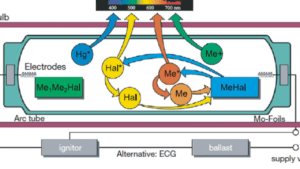 That’s why it operates at a much higher pressure than standard MH bulbs. The ceramic arc tube is necessary to slow down the caustic breakdown effect that the unique mixture of salts and halides use. It’s this mixture that creates the broad spectrum and then, in turn, gives growers the enhanced photosynthetic photon flux levels. Basically the claim is that your plants can enjoy and near full-spectrum white light, very similar to natural sunlight that lasts longer than your HIV counterparts.
That’s why it operates at a much higher pressure than standard MH bulbs. The ceramic arc tube is necessary to slow down the caustic breakdown effect that the unique mixture of salts and halides use. It’s this mixture that creates the broad spectrum and then, in turn, gives growers the enhanced photosynthetic photon flux levels. Basically the claim is that your plants can enjoy and near full-spectrum white light, very similar to natural sunlight that lasts longer than your HIV counterparts.
How do CMH Light Color Compare to the “Best Light”
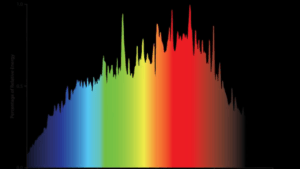 The color rendering index of the sun is 100. HPS lights are roughly 20 to 30 while metal halides are 60 to 65. CMH lights come in at 90 to 92 making them only about eight points off from our most natural sunlight. An added bonus aside from the quality of the spectrum is a lower heat output and power consumption with lower Watts. That means you’re going to have less heat in your tent and less of a toll on your electricity bill.
The color rendering index of the sun is 100. HPS lights are roughly 20 to 30 while metal halides are 60 to 65. CMH lights come in at 90 to 92 making them only about eight points off from our most natural sunlight. An added bonus aside from the quality of the spectrum is a lower heat output and power consumption with lower Watts. That means you’re going to have less heat in your tent and less of a toll on your electricity bill.
How do CMH Lights Compare in Heat?
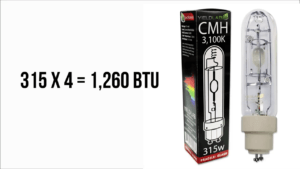 So to break it down, one watt from a grow light creates about four BTUs of heat that needs to be cooled. In comparison, one 600 watt HPS light puts off about 2,400 BTUs and one 315 watt CMH light puts off only 1,260 BTUs, which is almost less than half the HPS light. With all that being said, with CMH lights in your tent, you’ll be running a much cooler tent and having to run your AC a lot less, keeping your electricity bill down. So with only 315 Watts, the CMH bulb is stated to produce far more PAR in a grow area than a 600-watt HPS bulb. But with all of these claims, there’s one question. How much better?
So to break it down, one watt from a grow light creates about four BTUs of heat that needs to be cooled. In comparison, one 600 watt HPS light puts off about 2,400 BTUs and one 315 watt CMH light puts off only 1,260 BTUs, which is almost less than half the HPS light. With all that being said, with CMH lights in your tent, you’ll be running a much cooler tent and having to run your AC a lot less, keeping your electricity bill down. So with only 315 Watts, the CMH bulb is stated to produce far more PAR in a grow area than a 600-watt HPS bulb. But with all of these claims, there’s one question. How much better?
How Much Better?
In order to prove or disprove this, tests inside a four by four grow tent were done. Several different grow lights were hung at the top and the thermometer was placed right in the middle of the tent. Each light was run for 30 minutes, then the temperatures were checked. First was a CMH light. The starting temperature was 74 degrees Fahrenheit. The CMH grow light raised the temperature to 86 degrees.
So in total, the CMH raised the temp of the tent by nine degrees in 30 minutes. Next, the 600-watt HPS grow light was tested. The starting temperature was 80 degrees. After running for 30 minutes, the temperature rose to 96 degrees. The increase on the HPS was a total of 16 degrees. A duel 315 Watts, CMH light and a new 450-watt prototype led grow light were also tested.
The starting temperature on the dual CMH was 76 degrees and after 30 minutes it had increased to 100 degrees. So in total, the dual CMH raised the temperature by 20 degrees. Lastly, was run the 450 watt led prototype.
The starting temperature was 72 degrees and after 30 minutes it had raised to 82 degrees. That’s a 10-degree increase. When comparing the heat test results, the CMH ran the lowest increase of nine degrees. This was followed up by the led prototype with a 10-degree increase. The HPS had a 16-degree increase while the dual CMH closely followed with a 20-degree increase.
What are the PAR Differences in HID Lights?
Now that we can clearly see the differences and key output by these lights, we can then run PAR tests to measure the light intensity between the CMH, the HPS, the LED, and the dual CMH. These are the results.
 This is a snapshot of the PAR charts. All lights were hung 36 inches or three feet above the ground. The 630 watt dual CMH grew light emits the most intensity out of the four charts, a strong 900 to 700 par rating in the middle and an average of 500 par in the outer area. If you were growing four plants in a four by four area, each plant will receive a near consistent light coverage throughout its growth cycle.
This is a snapshot of the PAR charts. All lights were hung 36 inches or three feet above the ground. The 630 watt dual CMH grew light emits the most intensity out of the four charts, a strong 900 to 700 par rating in the middle and an average of 500 par in the outer area. If you were growing four plants in a four by four area, each plant will receive a near consistent light coverage throughout its growth cycle.
Under the dual CMH, there is a significant difference in PAR rating between the duals 630 Watts CMH and the single 315 Watts CMH. Coverage is still consistent overall, but a single bulb impacts intensity in certain applications. I recommend using the 315 watt for smaller grow tents or only utilize it for the vegetative cycle. The traditional HPS 600 watt bulb shows the second most intense light with the test showing 600 to 700 PAR ratings in the middle of the canopy and tapering off to 500 to 300 and the outer area.
When looking at these numbers, in conclusion, I would rank the dual CMH as the most intense light in these tests. Couple that intensity with the quality of spectrum, you can’t go wrong with this type of setup, using a grow tent in any home grow.
How are they for Spectrum?
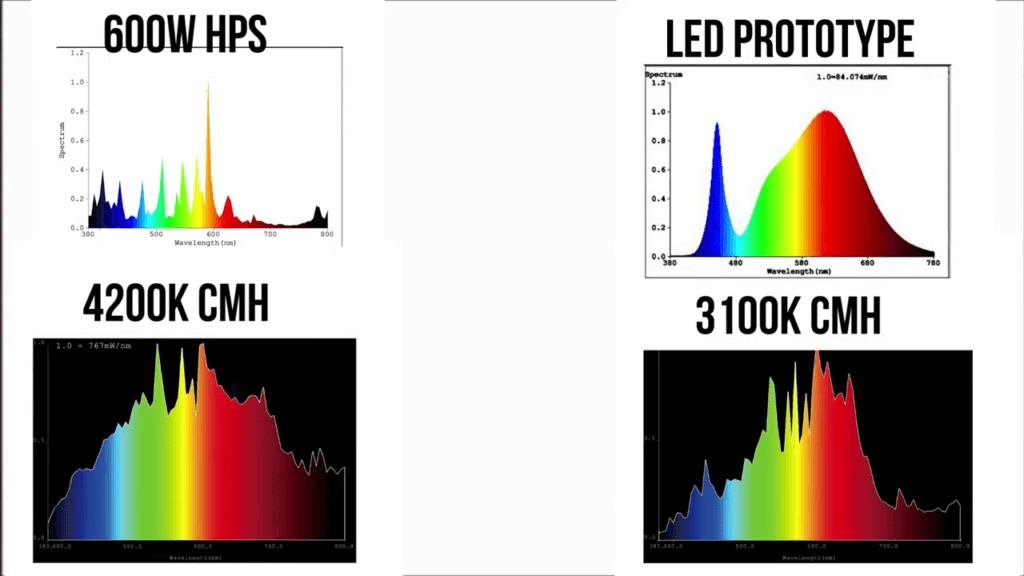 Looking at these graphs, you’ll notice a few impressive features that the CMH bulbs have versus the HPS grow bulbs. One major difference is how complete the CMH spectrum is, and not only that but the addition of stronger UV production. The HPS grow bulbs are very focused on the near red spectrums, which is great if you’re utilizing the HPS bulb as your one-trick pony for flowering.
Looking at these graphs, you’ll notice a few impressive features that the CMH bulbs have versus the HPS grow bulbs. One major difference is how complete the CMH spectrum is, and not only that but the addition of stronger UV production. The HPS grow bulbs are very focused on the near red spectrums, which is great if you’re utilizing the HPS bulb as your one-trick pony for flowering.
The CMH 3000 came with its wide array of available spectrums that makes it a full cycle bulb. We recommend the three K bulb from clones to flowering, and the four K is a broader spectrum bulb that leans towards the more vegetative focused plants. It can be used to supplement for flowering, but the three K is more than adequate.
Light Intensity
The 315 watt CMH bulb is equivalent to a 600 watt standard HIV grow life when it comes to spread. However, the light is more intense, provides a higher quality spectrum and has half the cost and half of the heat. CMH bulbs will cost you more out of pocket, but in the long run they’ll save you much more money. It’s the best possible lighting for in-home growing. It’s cheap to set up efficient, runs cooler than an HPS or double-ended bulb, and with the standard of over 1.3 grams per watt for hemp growers, new growers can’t go wrong.
The Best CMH Grow Lights for 2020
There is a lot of selection in CMH lights but all of the reviewers (and myself) agree on these top five for the best CMH grow lights for 2020.
Please note that this site is supported by affiliate marketing which means that a small portion will be paid to maintain this site from any purchases made through it. This in no way affects the price of the products on this page.
1. VIVOSUN 5-Mode-Adjust 315W CMH/CDM Grow Light Fixture
HIGHEST REFLECTION/BEST ECONOMY
- High-Reflectivity VEGA Aluminum Hood
The cutting-edge hood made of imported Italian VEGA aluminum boosts reflectivity by 20% compared to standard aluminum reflectors; Unit has an excellent light reflectivity rating of 98% ; Contouring of the polished reflective surface ensures no hot spots or dead spots.
According to the number of plants and the planting area, the irradiation area of 5 different gear positions can be adjusted. VIVOSUN self-developed, patented design.
- Grow Light Coverage
VIVOSUN recommends use of this unit to cover an area of approximately 3*3 feet during vegetative growth and approx. 6 square feet during the bloom phase.
- High-Tech Ballast
Advanced Low Frequency Square Wave Technology
High efficiency, reliability and no electromagnetic interferenceProtection system.
Overheating protection, End-of-bulb-life protection, Short-circuit protection, Ignition-failure protection
High-Reflectivity VEGA Aluminum Hood
The cutting-edge hood made of imported Italian VEGA aluminum boosts reflectivity by 20% compared to standard aluminum reflectors ; Unit has an excellent light reflectivity rating of 98% ; Contouring of the polished reflective surface ensures no hot spots or dead spots.
VIVOSUN 5-MODE ADJUSTABLE 315W CMH/CDM GROW LIGHT FIXTURE: THE VERDICT
This 315 W fixture does a decent job. It is highly energy-efficient, plus you do not need any sort of cooling fans, as it can be air-cooled. However, if your plants are placed in an enclosed space, then you will surely need to vent. I definitely recommend the VIVOSUN 5-Mode-Adjust 315W CMH/CDM Grow Light Fixture. Click HERE to learn more!
2. Sun System LEC 315
BEST OVERALL
The Sun System Light Emitting Ceramic Metal Halide light is by far the best option on the market in 2019. Nothing else really comes close in terms of quality. Naturally, that means it’s a bit more expensive than most competing brands, but if you can afford it, it’s worth the extra cost.
It includes everything you need to light your plants, so you can just plug it in and start growing. You get an all-in-one hood reflector, which means it contains the ballast needed to power the lamp. The bulb socket is at the top of the hood, so the bulb hangs vertically. This makes for a more even light spread than a horizontal bulb.
The inside of the hood is 98% reflective German aluminum with 95% reflective textured corners. This ensures optimal output and uniformity, meaning you are losing as little light as possible from the reflection and there are no hot spots that can burn your plants. It gives you a coverage area of 4 by 4 feet.
Bulb Included!
Along with the quality hood, the kit also includes a Philips Master 315W CMH bulb. The kit linked to here includes the 3100K bulb, but there is also a kit available with the 4200K bulb instead. The 4200K bulb is better for vegging, so some growers use it if they are getting a light for the whole grow cycle.
Personally, I think the 3100K does fine with vegging and it’s so much better at flowering, that I would just go with that one for everything unless I was going to use the light for vegging only. Basically, the increase in vegging efficiency of the 4200K spectrum is more than offset by the increase in yield of the warmer 3100K spectrum.
The Philips bulbs have an initial lumen output of 33,000 and a very high 1.95 PPF (photosynthetic photon flux) per second. In short, they give you a huge output considering they only consume 315 watts. Their open rated construction reduces radiant heat from the arc tube. As a result, this kit runs much cooler than a comparable HPS or MH light.
Longer Life
Furthermore, these lamps last a long time, with an expected lifespan of 20,000 hours. More importantly, they retain 90% of their lumen output after 8000 hours of use and still retain 85% of their PPF output after 20,000 hours. It should come as no surprise that this quality bulb is also our recommendation for the best CMH bulb (see below).
The ballast included in the reflector is a 50/60 Hz low frequency, square wave, electronic ballast, with a rated lifespan of 50,000 hours. Square wave is a newer technology that provides a more constant maximum voltage to the lamp, resulting in a more steady light. Also, their lower frequency means no issues with RF interference.
The whole Sun System CMH kit is covered by a 1-year warranty and there is also a 240 V version available. It gets a Grow Light Info rating of 4.8 out of 5.
Pros
- All-in-one construction — ballast is built into the hood, making this kit much more compact than others
- Bulb hangs vertically — more even light spread than a horizontal bulb
- Huge amount of light — given the 315w consumption, the bulb gives you a huge 33,000-lumen intensity
- Long lifespan — the high-quality bulb is rated for 20,000 hours and retains 85% of its PPF output in that time
- Square wave ballast — no issues with RF interference and a much more steady stream of light
- Low heat — this light does not need to be ventilated
- Free ratchet hangers — a free set of ratchet hangers is included
Cons
- High price — higher price than competing lights, but, as usual, you do get what you pay for
Check it out on Amazon HERE!
3. SunStream 630W Double Bulb CMH Grow Light System Include Bulb
Of course, because this is a double bulb system, it is much more expensive than the single bulb units. Of course, the coverage area and light intensity is that much more as well. The three-year warranty shows that this company stands behind its fixture. It features:
- PROFESSIONAL RESULTS MADE EASY: This CMH fixture runs significantly cooler compared to conventional lighting setups and does not need to be cooled with ducting and fan, they can simply be air-cooled and are really energy efficient
- HIGH-TECH BALLAST: Cutting-edge adjustable ballast features advanced low-frequency Square-Wave technology for high efficiency, reliability, and no electromagnetic interference. 8′ power cord with 3-pronged plug, compatible with Standard North American outlets
- ULTRA-HIGH REFLECTIVITY RATING: Sturdy reflective hood is made of German aluminum rated at 98% reflectivity; the contour design and texturing eliminates hot spots and dead zones
- GROW LIGHT COVERAGE: SunStream recommends the use of this unit to cover an area of approximately 9 square feet during vegetative growth and approx. 6 square feet during the bloom phase
- EFFICIENT, FULL-SPECTRUM LIGHT: This fixture delivers a more efficient spectrum for growing than HPS systems. PGZ18 lamp socket. 3-year warranty of ballast and 1-year warranty of lamp
4. Best CMH Grow Bulb: Philips Master 3100K GreenPower Elite Agro 315 Watt CMH Lamp
The Philips Master 3100K GreenPower Elite Agro 315 Watt CMH Lamp is as good as it gets.
It gives you 33,000 lumen of intensity, which is incredible for a bulb that only uses 315 watts. Moreover, it retains 90% of that after 8000 hours of use.
The rated lifespan of this CMH lamp is 20,000 hours and even at that point, it still retains 85% of its initial PPF, which is an unbelievably high 1.95 PPF (photosynthetic photon flux) per watt per second.
Philips uses a unique open rated grow lamp construction that reduces radiant heat from the arc tube and makes their bulbs perfect for open fixtures. Simply put, they emit far less heat than comparable HPS and MH grow lamps, greatly reducing the need to cool your grow space.
The grow bulb we’ve linked to in this review has a 3100K color spectrum, which is our preferred bulb to use for all stages of growth. It is a flowering monster and does well in vegging too.
There is a 4200K version available as well, the Elite MW 4200K Master Color CDM Lamp, for indoor growers who plan on only using it for vegging or for those who prefer a full-cycle bulb with more blue spectrum light (to me, flowering performance is the most important).
Pros
- Huge output — given the 315w consumption, this bulb gives you a huge 33,000 lumens
- Long lifespan — the bulb is rated for 20,000 hours and retains 85% of its PPF output in that time
- 1.95 PPF/w/s — incredible efficiency, with very high lumens per watt consumed
- Low heat — this light does not need to be ventilated
Cons
- High price — higher price than competing brands, but as usual, you do get what you pay for
Click HERE to find out more on Amazon
5. Best Budget CMH Bulb: Protopia CMH 315 Watt 3100K
If you’re looking to save some money on grow bulbs, there are a lot of options available, considering that the Philips grow lamps are among the most expensive. Unfortunately, many of the cheaper models simply are not very good. An exception is the Protopia 315 watt 31ooK CMH bulb.
In terms of intensity, this grow bulb is actually more powerful than the Philips initially, with an output of 37,000 lumens. The problem is that this deteriorates much more rapidly than it does with the Philips. In fact, the rated lifespan of this bulb is only 15,000, a full 5000 hours less.
The PPF per watt per second is also lower, at 1.81. This means the bulb is not as efficient as the Philips bulb at turning the power you feed it into usable light. All that said, given how much less the Protopia grow light bulb costs than the Philips bulb, it is definitely worth considering. It easily outperforms other similarly priced ones.
The version we linked to has a 3100K color temperature, but there is also a 4200K version available. You’ll find it on the same page as the 3100K CMH bulb—simply select the 4K color option to check that one out.
Pros
- Low price — costs considerably less than the brand above
- Huge initial output — the Protopia beats even the famous brand above with 37,000 lumen
- 1.81 PPF/w/s — great efficiency, with very high PPF per watt consumed (but not as high as the Philips)
Cons
- Faster deterioration — the grow bulb becomes less bright much more quickly than the previous grow bulb above (but similar to most others)
- Shorter lifespan — the Protopia does not last as long as our top choice for indoor growers
Conclusion: Best CMH Grow Lights for 2020
I hope that this blog was informative as to what CMH lights are and which ones you might like. There are great selections for the inexpensive to the more expensive – depending on your needs. For myself, I feel that the Vivosun is the best CMH Grow Light for 2020 and has been in subsequent years. It is not overpriced and really delivers. Anybody who is into grow lights has to have heard of Vivosun! The other options are excellent as well and I hope this has made things a bit “brighter” for you! Please feel free to follow and share and please make sure you give your comments below, especially if you have your own favorite!
Related Posts
Can You Profit From Hydroponics?


5 (8) Did you hear the story of a farmer who started growing strawberries? Yes? But, do you know he…
Conventional vs. Organic Hydroponic Nutrients


0 (0) Are “Organic” nutrients really better for your system or for your customers? Find out in this video from…

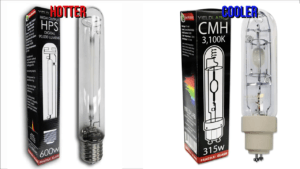
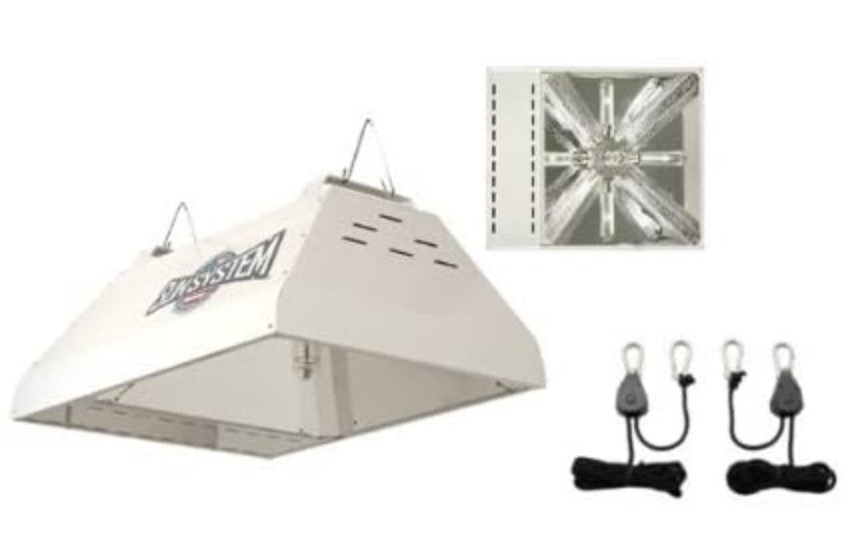
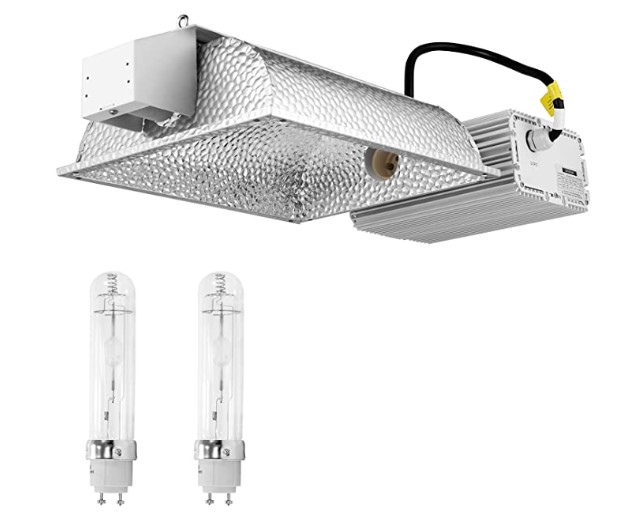
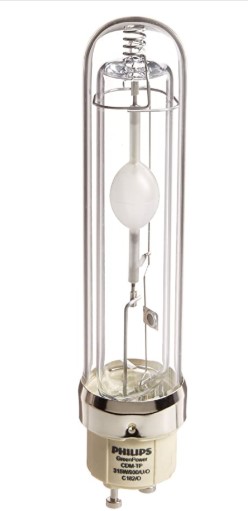
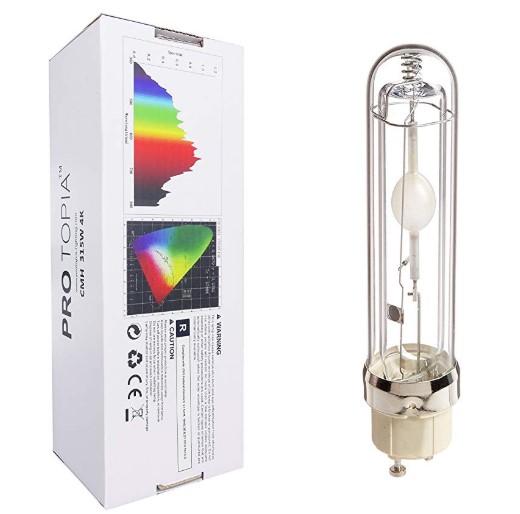


Thanks for the very thorough and informative article about CMH. I make it my business to learn something new every day. I learned a lot from reading what you wrote. As someone who grew up in the 60’s and 70’s, when I hear the term “grow lights”, I know what it makes me think of, and I’m guessing that’s what you’re implying these lights are best used for. “Grow your own” is a term I’m very familiar with. Good job. Keep up the good work. Take care.
Bob
Yes, these do an excellent job with marij-tomatoes – LOLOLOL. Yes, people use them for veggies and for hemp (for CBD oil production) so they would be just as good as for what you have in mind! Love ya, Bob!
This a very interesting and helpful site. Being able to grow indoors could become increasingly important, particularly with the growing risk of climate change. People may well find themselves living somewhere where the climate changes so much that they must consider alternative growing techniques for their basic needs. Your site is really helpful in terms of guidance for that. You make some excellent suggestions for different types of growing lights. If you live in the extreme north or southern hemispheres, or if there is significant climate change, these could be invaluable.
But equally for professional farmers and growers there is some very good advice here. Do these lights draw much voltage? Can they be operated effectively and reliably by renewable energy? Could a farmer using a windmill or solar energy depend on that energy supply to ensure these lights continue to operate?
Overall, I think you have an excellent and really useful site. Good job!
Thank you so much for your insightful comments! These lights draw much less voltage (or more importantly, amperage) than the other types of grow lights so they will definitely be cheaper to run. Having said that, I cannot answer your very interesting question of if you could go completely off the grid with them. It would REALLY depend on how much electricity your windmill or solar units can produce which would change from locale to locale. Right now, I am thinking probably now but every year the lights are getting more and more energy-efficient, so who knows what the future will bring?
Hi Darlene,
Thank you for the detailed and thorough reviews on the best CMH grow lights for growing our own food indoors. We live in Arizona state. At home, we only had an experience with LED grow light since we don’t have a huge amount of seedlings or plants indoors. We are beginner gardeners. We have a lot to learn. This Spring we are trying to use hydroponic system since we want to save time and money in terms of water bills and we also choose low maintenance plants. We’ll see how it goes.
I’ve learned a new thing again today from your post. Personally if I could choose from the list of CMH grow lights you mentioned in your post, I would choose the CMH grow light that is all-in-one construction, has longer life and come with bulb. Those would be some of the criteria for me to choose which CMH grow light I want to buy.
Thanks,
Ferra
Actually, a hydroponic system will take LESS water than a soil-based system because it is enclosed. There is nowhere for the water to either runoff from or evaporate from so I would think this would be ideal. Although you have excellent light there if you are growing inside you could still use a little extra and I feel that of all the HID lights, CMHs are the least expensive while giving the best spectrum and intensity. You really can’t go wrong!
Hi,
So, these indoor lights use ceramics? I did not know that was possible, but I love that it creates a more natural light instead of a strong (sometimes blinding) hue (I am a little sensitive to strong lights). I find it interesting how the ceramic tube works and how it creates light that comes close to natural sun light.
Would an indoor growing tent be ideal for plants that are not native to your area? Could you perhaps re-create their environment with the right temperature and light?
The Protopia seems like a good lamp, and at a great price. If it is even more powerful than the Phillips lamp, but it has a shorter lifespan, I think I would still prefer the Phillips and also the Sunstream 630, because the latter can simply be aircooled.
If you are thinking of tropical plants, they would do GREAT in a grow tent. You would still want to watch your temperatures for the first while so that they don’t get “baked” by the lights but I would think that they would flourish. Also, for those humidity loving plants, a grow tent will keep that in, too, making them grow like crazy! I will be doing an article on grow tents next week so watch out for it!
Well I must say that I was pleasantly surprised at what I found on this site. I knew I would find lighting products but there was so much more useful information, great recommendations and first hand experience content. We just changed about 400 lighting aids at work and the light quality is now very good, so there is some shared ground. There is some super information on what light to use around or near plants which is great for gardeners. Also a pro’s and con’s list can help buyers to choose the products that they need.
I think this is a great niche and would recommend this to both friends and professional electricians, great site.
Thank you very much! I hope the site encourages you to grow your own food indoors as well as bask in the tropical lights for your tan! LOL Thank you so much for your comment!
I’m someone who would make a higher upfront investment, so for me I’d be willing to pay more for a light that’s going to have a longer lifespan than one that’s going to have a shorter span, even the latter is at a cheaper price. I believe that over the course of time you’re going to end up paying more for the cheaper options and less for the more expensive ones in terms of lifespan.
I could NOT agree with you more. However, there are people out there that aren[t sure if they will keep on growing inside or if they will be successful at it so they just buy a cheap one until they are either sure or decide not to continue.
The quality of the light spectrum of CMH bulbs is a no brainer. Also, anyone growing errr tomatoes indoors back in the day know what an energy suck the old bulbs were, not to mention the heat output! Luckily, gardening naked INdoors won’t get you in trouble anywhere ha!
Anyone who gardens consciously and sustainably should be using CMH bulbs in my opinion or, even LED’s that you’ve written about before. I have the luxury of growing outdoors (I feel for you having to be indoor based) in Oregon but, I don’t get the year-round growing season I did in California.
I just moved into my sanctuary, great piece of land and a garage that’s as big as my house! I say that because you’ve now inspired me to get a rig for the winter months so, I can at least keep my kitchen herb staples going year round! I think your all around 3100K might be best for my needs.
Ahhhhhh – Your garage space sounds WONDERFUL for growing… tomatoes. Either that or get a grow tent to put in a corner. Just make sure that tomatoes completely fill the space or you are losing a lot of light shining at nothing. If you are going to do it in a room rather than a tent, believe it or not but flat white paint is the absolute best for the walls.
Best of luck!!!
Wow.. I didn’t know there was this much information on a light lol.. You definitely did your research on this one. Good topic too in today’s society. As Marijuana has been legalized in more country’s there’s going to be a lot more people looking into growing their own. Keep up the great job!
Thank you so very much! Keep on growing!
This was a very useful review on grow lights. I know some folks that have indoor plants growing under lights and I had no idea that they could choose from the various types of grow lights. I would have thought it was simple but now I feel more educated as to the pros and cons of the CMH systems as opposed to the older tech of the HPS lights. I will share this article with my friend and keep it in mind if I choose to grow a home garden of some type. It’s good to know that such systems provide everything you need. thanks
Grow lights are continually getting cheaper and more energy-efficient so its just a matter of knowing which is the best for you. Best of luck to you and your friend!
Hi Darlene,
I wish I could come across your article 3 years ago when I was looking for artificial light to start growing Boston Ivy in the dark narrow space between the porches. As they grow enough above the deck level, they would have enough light, but to start them from young sprouts was a problem, and I need this exact light!!! Well, spending of $200 was not in my budget plan, but I see that there are some cheaper options…
Well, since I didn’t have this information earlier, only 1 out of 4 sprouts survived. 🙁
Thank you for the great information – I’ll be smarter for the future! 🙂
~ Julia
Awwwwww! Is the one that survived big enough that you can take cuttings off of? Best of luck!
It’s was big enough last year but didn’t seem mature enough yet; it still looked too fragile. Maybe this year… Thanks for another great tip, Darlene!
Be well,
~ Julia
DARN! Well, as you say, maybe next year. Or maybe you have a neighbour with some bigger ones and some night you could go for a walk with a pair of scissors… 😉
Hahaha, Darlene! ? That’s what I was planning to do 3 years ago ✂, but didn’t find Boston Ivy in Boston neighborhood!!! Can you imagine?! Well, there are plenty in Boston, but we are a bit North from the city. Anyway, I ended up ordering it online.
The real problem is not to get a new plant but to plant it. The soil is hardly reachable through the narrow gap between the porches. My poor husband had to crawl under the deck to plant it the first time.
LOLOLOL. Best of luck with it! Maybe a little plant food?
Thank you Darlene for this qualitative and highly informative publication on CMH Grow Lights. It is very obvious that these CHM grow lights will certainly help farmers to increase agricultural in a continuously increasing world population but don’t you think that they can also be use for Still Image and Video shooting?
Wow! Now that is something I had never thought of! Since, of all the lights out there their spectrum is closest to that of the sun it just might work. If any other photographers have an opinion, please jump into the conversation!
This was a really informative post on a subject I didn’t know much about beforehand. I had been interested in the prospect of growing indoors, especially herbs and vegetables, but didn’t really know how to go about it. The way my apartment is situated, I really can’t get enough good quality light to sustain any growth, so one of these might be the answer to my problem. I really didn’t find them all that expensive, even at the highest price point. Thanks for the suggestions!
Thank you! I’m so glad it helped. There really just anything better than herbs and food you have grown yourself! In my humble opinion, the CMH lights are the best grow lights out there.
Hi Darlene! Thank you for stopping for a while on the spectrum topic. I have read a couple of post before yours and I was surprised that none of both that I read previously dwelt on the spectrum. I’m impressed with these CMH bulbs and their impressive features compared to HPS grow bulbs. Yeah, how complete the CMH spectrum is!
You’re absolutely correct. I haven’t seen as good a spectrum on ANY of the other lights I’ve reviewed. They aren’t horribly expensive either, which was a surprise to me. Thank you for checking out my site!